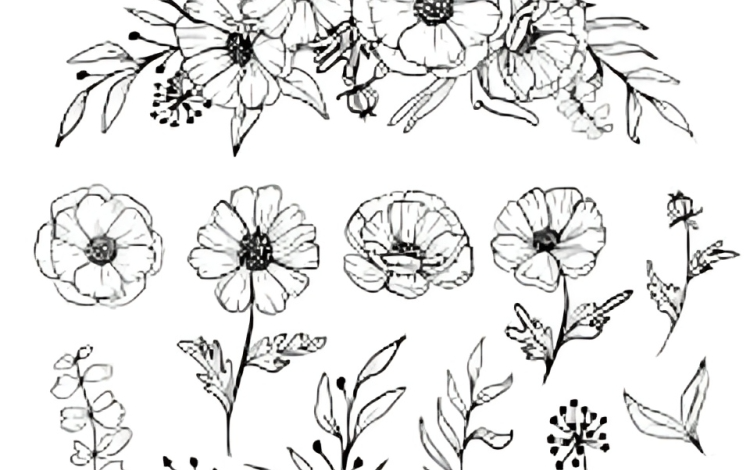The Art of Flower Drawings Tips, Techniques, and Inspirations for Beginners and Artists

Flower drawings have captivated artists and art enthusiasts for centuries. From delicate petals to vibrant blossoms, flowers offer endless opportunities for creativity. Whether you’re an aspiring artist looking to learn or a seasoned professional searching for inspiration, flower drawings provide an excellent way to express your artistic abilities. In this article, we will explore the various techniques, tips, and tools for drawing flowers, along with inspiration to create your own beautiful floral masterpieces.
Why Flower Drawings Are So Popular
Flower drawings have a timeless appeal because of the natural beauty and variety they offer. Every flower has its own unique shape, color, and texture, allowing artists to experiment with different mediums and techniques. Flowers can symbolize many things, from love and beauty to hope and renewal, making them a perfect subject for art.
Moreover, drawing flowers is accessible to artists of all levels. Whether you’re just starting or are an experienced drawer, the simplicity or complexity of flowers means that there’s always something new to learn or challenge yourself with. Drawing flowers can also be a meditative and relaxing practice that connects you to nature.
Basic Flower Drawing Techniques
Before diving into detailed flower drawings, it’s important to understand a few basic techniques that will help you create more realistic and beautiful flowers. Here are some steps and tips to get you started:
1. Start with Simple Shapes
Flowers can be broken down into basic shapes like circles, ovals, and triangles. Begin your drawing by sketching the basic outline of the flower. For example, the center of a daisy can be drawn as a small circle, and the petals can be drawn as elongated ovals or teardrop shapes. This is the foundation of your flower, and from here, you can add details like texture, shading, and depth.
2. Focus on Proportions
Proportions are crucial when drawing flowers. Pay close attention to the size and placement of the flower’s parts. The petals, stem, and leaves should all be in proportion to each other. A helpful tip is to lightly sketch the flower’s components before refining them. You can erase or adjust the proportions as needed. For example, a sunflower’s petals are much larger than the center, while the delicate petals of a lily may be long and slender.
3. Use Light and Shadow for Depth
One of the most important aspects of flower drawing is creating depth. This is where shading comes into play. The petals of a flower, depending on their angle to the light source, will have highlights and shadows. Begin shading by determining where the light source is coming from, and then darken areas that would naturally be in shadow. Use gentle strokes for soft petals, and heavier strokes for leaves and stems.
4. Add Details
Flowers are full of intricate details, and capturing them will bring your drawing to life. Pay attention to the texture of the petals, the veins in the leaves, and the tiny structures in the flower’s center, such as the stamens and pistils. Use fine lines for delicate details, and take your time adding small touches that make the flower look more realistic.
5. Experiment with Different Mediums
Flower drawings can be done in a variety of mediums. Graphite pencils, charcoal, colored pencils, ink, and even watercolors are all great choices for creating beautiful flower art. Each medium has its own unique qualities that can bring out different aspects of the flower. For instance, watercolors can add a soft, ethereal feel to a flower, while colored pencils can create bold, vibrant details.
Flower Drawing Styles to Explore
There are many different styles of flower drawings, from hyper-realistic to stylized interpretations. Each artist can bring their unique perspective to flower art. Here are some popular flower drawing styles to explore:
1. Realistic Flower Drawings
If you want to create lifelike representations of flowers, practicing realism is essential. Realistic flower drawings require keen attention to detail, careful observation of how light falls on the petals, and patience. Artists often use shading techniques to replicate the natural texture of flowers. These drawings tend to be more time-consuming but rewarding when the results are achieved.
2. Minimalist Flower Drawings
Minimalist flower drawings focus on simple lines and shapes. Rather than capturing every intricate detail, the goal is to suggest the form of the flower in a simplified way. This style is perfect for beginners, as it emphasizes basic shapes and lines. It also appeals to those who prefer a modern, clean aesthetic. You can achieve this by using single-line drawings or subtle shading.
3. Abstract Flower Drawings
Abstract flower drawings take creative liberties with the form and structure of the flower. Artists may exaggerate certain features, like the size of the petals, or experiment with colors that aren’t typically found in nature. Abstract art allows for more freedom and can be a great way to express emotions or ideas through flowers. Using bold lines, geometric shapes, and vibrant colors are common in abstract flower artwork.
4. Botanical Illustrations
Botanical illustrations are detailed, scientifically accurate representations of flowers and plants. These drawings often include a focus on the anatomy of the flower, with clear labeling of parts like the petals, stem, and leaves. Botanical art is often drawn with fine lines and can involve both black and white drawings or color accents. If you’re interested in capturing the true structure and biology of flowers, botanical illustration may be the style for you.
Popular Flowers to Draw
There are so many types of flowers to choose from when creating your artwork. Here are some popular flowers that are often drawn, each offering its own unique shape and structure:
1. Roses
Roses are one of the most iconic flowers in art. With their layered petals and rich symbolism of love, roses can be drawn in many different styles. The key to drawing a rose is capturing its curves and gentle folds. You can create intricate detail by focusing on the overlapping petals and adding depth through shading.
2. Sunflowers
Sunflowers are bright and bold, making them an excellent subject for flower drawings. Their large, circular centers and long, slender petals make them visually striking. Whether you choose to draw them realistically or in a more stylized way, sunflowers offer an opportunity to play with proportion and color.
3. Lilies
Lilies are known for their elegant, trumpet-shaped blooms. Their large petals and symmetrical design make them a favorite among artists. You can draw lilies in a naturalistic way, emphasizing their graceful lines, or experiment with abstract interpretations of their shape.
4. Tulips
Tulips are another popular flower for drawings. Their smooth, rounded petals and tall stems make them perfect for capturing both simplicity and beauty. Tulips come in a variety of colors, so you can experiment with vibrant hues or opt for a more muted, monochrome palette.
5. Daisies
Daisies are simple yet charming flowers that are often drawn by beginners. Their round center surrounded by petal-like “rays” makes them easy to sketch. Daisies can symbolize purity and innocence and can be a great subject for a light, fresh composition.
Tips for Improving Your Flower Drawings
To create truly beautiful flower drawings, you must continue to practice and refine your skills. Here are some additional tips to help you improve your flower art:
- Use References: Look at real flowers or photos to understand their structure. Pay attention to the angles, details, and shading of the petals.
- Practice Different Flowers: Each flower has its own unique characteristics. Try drawing different types of flowers to challenge yourself and expand your skills.
- Start Simple, Then Add Detail: Don’t be afraid to start with basic shapes and build upon them. Flowers may seem complicated, but breaking them down into simpler parts can make drawing them easier.
- Keep Experimenting: Don’t be afraid to try new techniques or mediums. Experimenting with colored pencils, watercolors, or even mixed media can give your flower drawings a new dimension.
Conclusion
Flower drawings are a timeless and versatile subject in the world of art. Whether you prefer capturing their delicate beauty in a realistic style or embracing a more abstract or minimalist approach, flowers offer endless possibilities for creativity. With practice and patience, you can refine your drawing skills and create stunning floral artwork that celebrates the beauty of nature. So grab your pencils, paper, and paint, and start exploring the vibrant world of flower drawings today!




